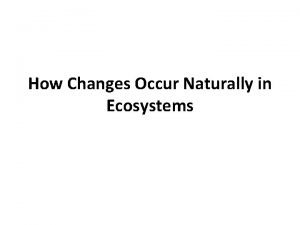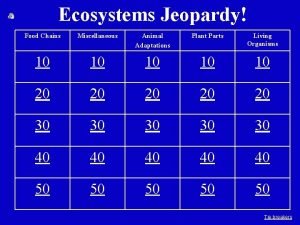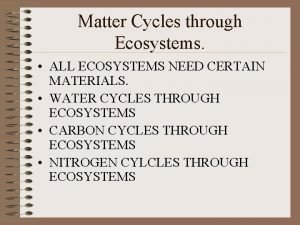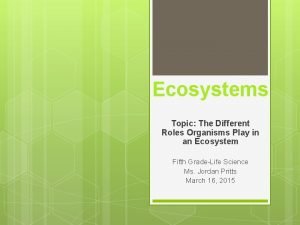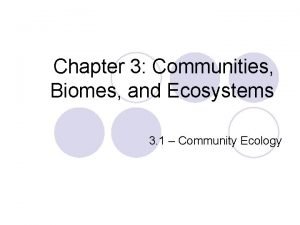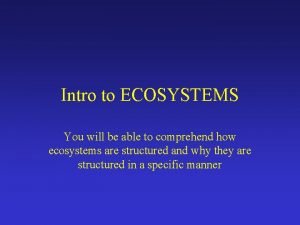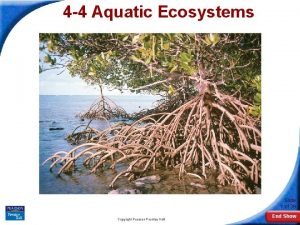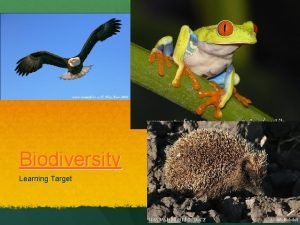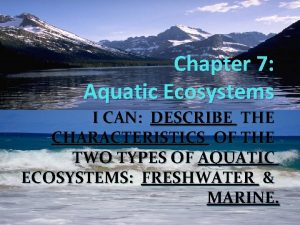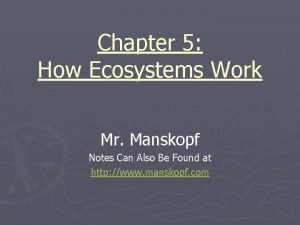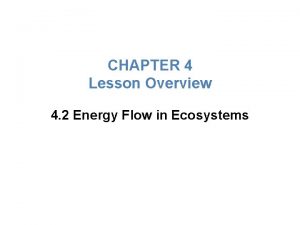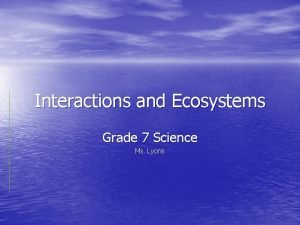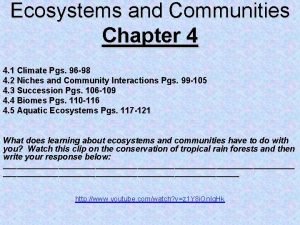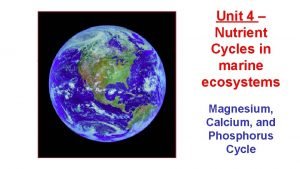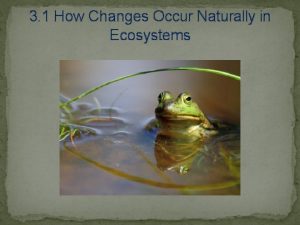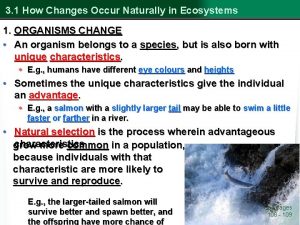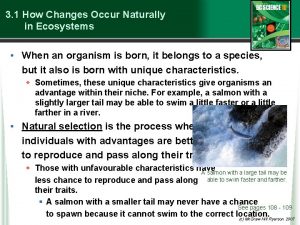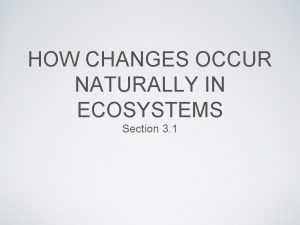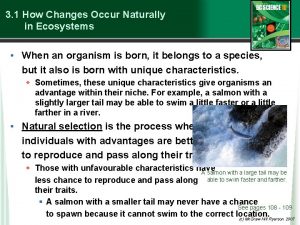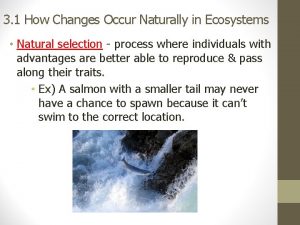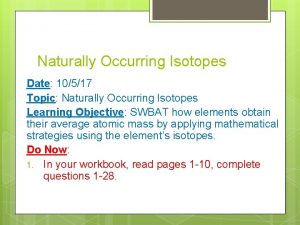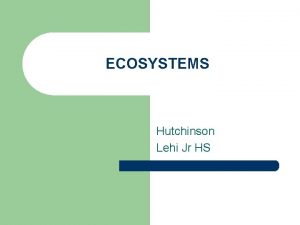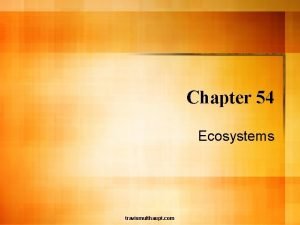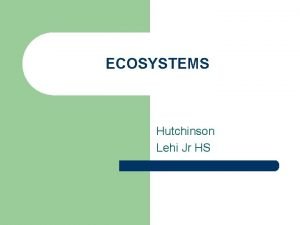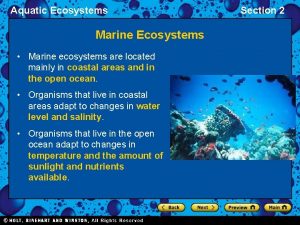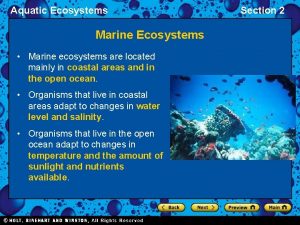3 1 How Changes Occur Naturally in Ecosystems






















- Slides: 22

3. 1 How Changes Occur Naturally in Ecosystems n Natural selection - process where individuals with advantages are better able to reproduce and pass along their traits. § A salmon with a smaller tail may never have a chance to spawn because it can’t swim to the correct location.

Three-Spine Stickleback Originally an ocean-dweller (only lived in salty ocean waters) 13, 000 years ago, the glaciers around BC retreated and some ocean water became lakes (freshwater).

The Sticklebacks in the lake adapted! As the salt water slowly changed to freshwater, the stickleback adapted. Now there are marine and freshwater species. Marine (left) and freshwater (right) guarding nests. . .

Question! n. Did the stickleback adapt to an abiotic or a biotic change in its environment?

In the lakes. . . n Sticklebacks in BC lakes have evolved into species pairs (one species lives and feeds at the bottom, the other species lives and feeds in surface waters) Bottom dweller Surface dweller What differences do you see?

In the lakes. . . There about 6 species pairs of sticklebacks in lakes around Vancouver Island. n Recently, 1 species pair or sticklebacks living in Hadley Lake (Lasqueti Island) has disappeared n Introduction of catfish to the lakes

Question! n. Did the stickleback adapt to an abiotic or a biotic change in its environment?

Example: The Finches of the Galapagos Islands (off the coast of Ecuador) Finches: There are 13 species on the island…

Provincial Exam Question

n All the species are descended from one finch species on the mainland. § Each species has unique characteristics that allows them to thrive in their own niche, and not compete with other finches for resources. n Adaptive radiation - a form of natural selection when many different species appear from one original species.

Famous Example n Charles Darwin – Galapagos Island Finches A number of different species have “radiated out” from one common ancestor to inhabit different niches.

Provincial Exam Question

ECOLOGICAL SUCCESSION Changes in the biotic characteristics in an area over time. Primary Succession Secondary Succession

1) Steps of Primary Succession a. Starts with bare rock. b. Wind carries spores of lichens that can survive on bare rock. c. Weathering breaks down rock soil begins to form

e. f. g. h. n Pioneer species make/improve soil other plants can grow animals appear form a mature community (stable and change slowly) Pioneer Species are the first organisms to survive and reproduce. § Examples: Lichens and mosses


2. Secondary Succession: § § when an area already has soil, but has had a disturbance like a forest fire or clearcut. Happens more quickly than primary because there already seeds, insects, worms etc. in the soil.

Secondary Succession

Provincial Exam Question

Disturbances that Might Cause Secondary Succession n Flooding – Leads to soil erosion, spread of pollutants and harmful bacteria associated with sewage – Climate change and global warming may be increasing incidents of flooding. – A tsunami occurs when huge waves, from large earthquakes, flood coastal areas.

n Drought n Insect infestation - Most insects are helpful, but when normal conditions change, infestations can occur. - Example: Mountain Pine Beetle: Usually it is not a problem…it helps remove old trees, but….

…in our forests there a lot of old trees, the climate is warming, and the bugs are not dying in the winter. Pine beetle has blue stain fungus in its mouthparts, which it transmits to the trees (symbiotic relationship). Fungus slows down resin production on trees so the beetle can eat the tree more easily. Take the Section 3. 1 Quiz
 Ecological succession stages
Ecological succession stages Elizabeth mulroney
Elizabeth mulroney Chemical vs physical change
Chemical vs physical change Section 3 energy in ecosystems
Section 3 energy in ecosystems Ecosystems jeopardy
Ecosystems jeopardy Matter cycling in ecosystems
Matter cycling in ecosystems Ecosystems jeopardy 5th grade
Ecosystems jeopardy 5th grade Orderly natural changes and species replacements
Orderly natural changes and species replacements Ecosystems examples
Ecosystems examples Intro to ecosystems
Intro to ecosystems 4-4 aquatic ecosystems answer key
4-4 aquatic ecosystems answer key Secondary succession examples
Secondary succession examples Why is biodiversity important
Why is biodiversity important Chapter 5 evolution and community ecology answer key
Chapter 5 evolution and community ecology answer key What are the two main types of aquatic ecosystems
What are the two main types of aquatic ecosystems Intraspecific competition
Intraspecific competition Unit 5 ecology
Unit 5 ecology Chapter 5 how ecosystems work study guide
Chapter 5 how ecosystems work study guide Chapter 4 lesson 2 energy flow in ecosystems
Chapter 4 lesson 2 energy flow in ecosystems Grade 7 ecosystems
Grade 7 ecosystems Do birds eat squirrels
Do birds eat squirrels Parasitism examples
Parasitism examples Biological use of magnesium in marine ecosystems
Biological use of magnesium in marine ecosystems
